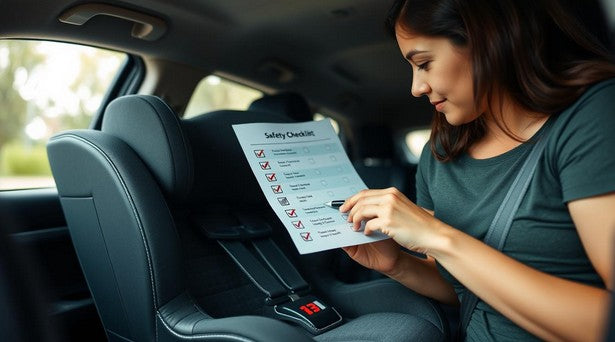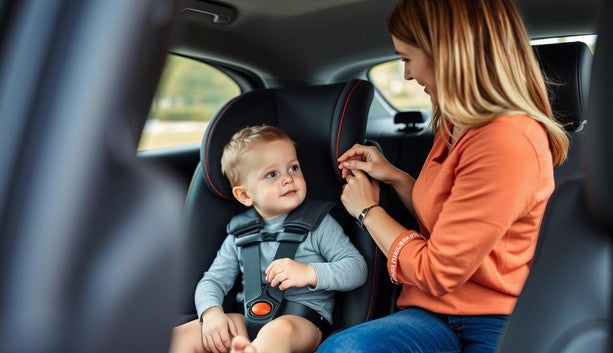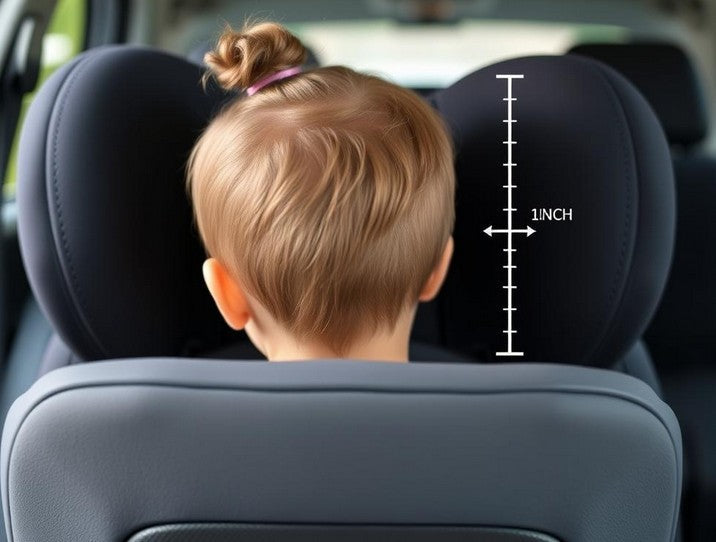Car seats are your child's most important protection during travel, yet studies show nearly 46% of all car seats are installed or used incorrectly. These mistakes can significantly reduce a car seat's effectiveness during a crash, putting your child at unnecessary risk. As parents and caregivers, understanding these common errors is the first step toward ensuring your little one's safety on every journey.
In this comprehensive guide, we'll identify the most frequent car seat mistakes, explain the specific risks they pose, and provide expert-backed solutions to correct them. Whether you're a first-time parent or experienced caregiver, these insights will help you provide the safest possible travel environment for your child.
Car Seat Safety: By the Numbers
According to the National Highway Traffic Safety Administration (NHTSA), car crashes remain a leading cause of death for children ages 1 to 13. However, proper car seat use can reduce the risk of fatal injury by up to 71% for infants and 54% for toddlers.
Despite this, car seat misuse is alarmingly common:
- Nearly half (46%) of all car seats and booster seats are installed incorrectly or used improperly
- 73% of car seats are not installed tightly enough or have harness straps positioned incorrectly
- 95% of parents make at least one mistake when installing an infant car seat for the first time
These statistics highlight why understanding common car seat mistakes is crucial for every parent and caregiver. Let's examine the most frequent errors and how to correct them.
Mistake #1: Loose Car Seat Installation
The Risk
A loosely installed car seat can move more than one inch side-to-side or front-to-back at the belt path. During a crash, this excessive movement increases the risk of head injury as your child may be thrown further forward, potentially striking the vehicle interior or experiencing more violent movement.
WARNING: A car seat that moves more than one inch at the belt path is not secure enough to properly protect your child in a crash.
The Solution
Dr. Benjamin Rodriguez, pediatrician and child safety expert, explains: "A properly installed car seat should not move more than one inch in any direction when tested at the belt path. This stability is crucial for protecting your child's head and neck during a collision."
To ensure proper installation:
- Place your knee in the car seat and press down firmly while tightening the seat belt or LATCH strap
- Check for movement by gripping the seat at the belt path (not the top) and attempting to move it side-to-side and front-to-back
- If the seat moves more than one inch, reinstall and tighten further
Mistake #2: Incorrect Harness Strap Positioning
The Risk
Improperly positioned harness straps can't effectively restrain your child during a crash. This increases the risk of ejection or allows excessive movement that can lead to serious injuries.
The Solution
The correct harness strap position depends on your child's car seat orientation:
- Rear-facing seats: Harness straps should come from at or just below your child's shoulders
- Forward-facing seats: Harness straps should come from at or just above your child's shoulders
According to NHTSA guidelines: "Proper harness positioning is essential for crash protection. When straps are in the correct position, they can better restrain your child and distribute crash forces over stronger parts of the body."
Mistake #3: Chest Clip Positioned Incorrectly
The Risk
The chest clip serves a critical purpose: it keeps the harness straps properly positioned on your child's shoulders. When positioned too low (on the abdomen) or too high (near the neck), it can't perform this function effectively, allowing the harness straps to slip off the shoulders during a crash.
FACT: The chest clip is a pre-crash positioning device. Its job is to keep harness straps properly placed before a crash occurs, not to restrain your child during impact.
The Solution
Always position the chest clip at armpit level. This placement ensures the harness straps remain properly positioned on your child's shoulders, where they can effectively restrain your child and distribute crash forces appropriately.
Ensure Your Child's Safety Today
Download our comprehensive Car Seat Installation Checklist to verify you've avoided all common mistakes. This printable guide walks you through proper installation and harness use step by step.
Mistake #4: Harness Straps Too Loose
The Risk
Loose harness straps create excess space between the restraint system and your child's body. During a crash, this allows for dangerous additional movement before the restraint begins working, increasing the risk of injury and potentially allowing partial ejection from the seat.
The Solution
Dr. Alisa Thompson, pediatric trauma specialist, advises: "Harness straps should be snug enough that you cannot pinch any excess webbing at the shoulder. This ensures your child is properly secured without room for dangerous movement during a collision."
To check for proper tightness:
- Buckle and tighten the harness
- Try to pinch the harness strap at your child's shoulder
- If you can pinch any excess webbing, the harness is too loose and needs further tightening
Mistake #5: Using Bulky Clothing Under Harness
The Risk
Puffy winter coats and bulky clothing compress during a crash, creating unexpected slack in the harness system. This compression can create up to 4 inches of dangerous slack, allowing excessive movement and potentially allowing your child to slip out of the restraint entirely.
WARNING: What feels snug before a crash may become dangerously loose during impact when bulky clothing compresses.
The Solution
NHTSA recommends: "Remove bulky coats and snowsuits before placing your child in their car seat. Instead, secure your child in the seat first, then place blankets or the coat over them as a cover."
For cold weather safety:
- Use thin, layered clothing that won't compress significantly
- Place blankets over your child after they're properly buckled
- Use a car seat cover designed to go over the entire seat (never place anything under your child or behind their back)
Mistake #6: Transitioning to Forward-Facing Too Early
The Risk
Turning a child forward-facing too early significantly increases their risk of spinal cord and neck injuries in a crash. Young children have disproportionately large heads and underdeveloped neck muscles, making them particularly vulnerable to these injuries when forward-facing.
The Solution
The American Academy of Pediatrics recommends: "Children should remain in a rear-facing car seat as long as possible, until they reach the highest weight or height allowed by their car seat manufacturer. Most convertible seats now have limits that allow children to ride rear-facing for 2 years or more."
For maximum safety:
- Keep your child rear-facing until they reach the maximum height or weight limit of their convertible car seat
- Don't use the minimum legal requirement (often age 2) as your guide—many children can and should remain rear-facing well beyond their second birthday
- Consider a convertible car seat with higher rear-facing weight limits (40-50 pounds) to extend rear-facing use
Mistake #7: Skipping the Top Tether for Forward-Facing Seats
The Risk
Without the top tether, a forward-facing car seat can pitch forward up to 4-6 inches more in a crash. This additional movement significantly increases the risk of head injury as your child may strike the vehicle interior or experience more violent movement.
FACT: Studies show that top tether use reduces head excursion (forward movement) by 4-6 inches in a crash, yet fewer than 50% of forward-facing car seats have the top tether properly connected.
The Solution
NHTSA guidelines state: "Always use the top tether with a forward-facing car seat, whether it's installed using the lower anchors or the vehicle seat belt."
To properly use the top tether:
- Locate the tether anchor in your vehicle (check your vehicle manual for locations)
- Route the tether strap according to your car seat manual
- Connect the tether hook to the vehicle's tether anchor
- Tighten until snug, removing all slack
Mistake #8: Using Aftermarket Products Not Approved by Manufacturer
The Risk
Aftermarket products like head positioners, strap covers, and seat protectors haven't been crash-tested with your specific car seat. These products can interfere with the car seat's designed performance, potentially creating unexpected slack, changing crash dynamics, or introducing new hazards.
The Solution
Car seat safety technician Maria Gonzalez advises: "Only use products that came with your car seat or are specifically approved by your car seat manufacturer for use with your exact model. If it didn't come in the box, assume it's not safe to use unless the manufacturer explicitly approves it."
For safe accessory use:
- Check your car seat manual for approved accessories
- Contact the manufacturer directly if you're unsure about a particular product
- Never place additional padding behind or under your child
- Avoid attaching toys or other items to the car seat that could become projectiles in a crash
- Mistake #9: Ignoring Car Seat Expiration Dates
The Risk
Car seats typically expire 6-10 years from the date of manufacture. Using an expired seat puts your child at risk because:
- Plastic components degrade over time, especially when exposed to temperature extremes in vehicles
- Technology and safety standards improve, making older seats less protective
- Replacement parts may no longer be available for recalled components
The Solution
Check your car seat's expiration date, typically found:
- On a manufacturer label on the bottom or side of the seat
- Molded into the plastic shell
- In the instruction manual
If your seat is expired or approaching expiration:
- Replace it with a new seat that meets current safety standards
- Properly dispose of the expired seat by cutting the harness straps and marking it as "EXPIRED" to prevent reuse
Mistake #10: Not Registering Your Car Seat
The Risk
Unregistered car seats mean manufacturers can't contact you directly about recalls or safety notices. This leaves you unaware of potential safety issues that need immediate attention, putting your child at unnecessary risk.
FACT: According to Safe Kids Worldwide, only about 42% of car seats are ever registered with manufacturers, leaving most families uninformed about critical recalls.
The Solution
Registration is quick and easy:
- Fill out and mail the registration card that came with your car seat
- Or register online at the manufacturer's website or at NHTSA's registration page
- Keep your contact information updated if you move or change email addresses
Even if you've been using your seat for a while, it's not too late to register. You'll need the model number and manufacture date found on the seat's label.
Car Seat Safety Verification Checklist
Use this quick reference guide to verify your car seat is installed and used correctly:
Installation Check
- Car seat moves less than 1 inch at belt path
- Car seat is at correct recline angle
- Lower anchors or seat belt is routed through correct path
- Top tether is connected for forward-facing seats
- Seat belt is locked if used for installation
Harness Check
- Harness straps at or below shoulders (rear-facing)
- Harness straps at or above shoulders (forward-facing)
- Harness snug (cannot pinch excess webbing)
- Chest clip at armpit level
- No bulky clothing under harness
EXPERT TIP: "The best way to ensure your car seat is installed correctly is to have it checked by a Certified Child Passenger Safety Technician. These trained professionals can identify and correct installation errors you might miss." — National Highway Traffic Safety Administration
Find a certified technician near you through the Safe Kids Certified Child Passenger Safety Technician Finder.
Protect Your Most Precious Cargo
Get our comprehensive Car Seat Installation Checklist to ensure your child's car seat is installed correctly every time. This printable guide includes all the verification steps covered in this article, plus additional tips from certified safety technicians.
Keeping Your Child Safe on Every Journey
Proper car seat use is one of the most important ways you can protect your child while traveling. By avoiding these common car seat mistakes, you significantly reduce your child's risk of injury in the event of a crash.
Remember that car seat safety is an ongoing process. As your child grows, their car seat needs will change. Stay informed about current recommendations, check your installation regularly, and don't hesitate to seek help from certified professionals if you're unsure about any aspect of car seat safety.
Your child's safety is worth the extra time and attention to detail. By making car seat safety a priority, you're providing the protection they deserve on every journey.




Leave a comment
This site is protected by hCaptcha and the hCaptcha Privacy Policy and Terms of Service apply.